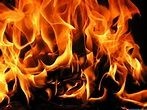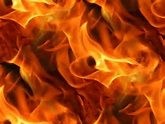https://upload.wikimedia.org/wikipedia/commons/6/6f/Feu-de-paille-couverture.ogg
Fire is the rapid oxidation of a material in the exothermic chemical process of combustion, releasing heat, light, and various reaction products.[1] Slower oxidative processes like rusting or digestion are not included by this definition.
At a certain point in the combustion reaction, called the ignition point, flames are produced. The flame is the visible portion of the fire. Flames consist primarily of carbon dioxide, water vapor, oxygen and nitrogen. If hot enough, the gases may become ionized to produce plasma.[2] Depending on the substances alight, and any impurities outside, the color of the flame and the fire's intensity will be different.
- Fire in its most common form can result in conflagration, which has the potential to cause physical damage through burning. Fire is an important process that affects ecological systems around the globe. The positive effects of fire include stimulating growth and maintaining various ecological systems. Fire has been used by humans for cooking, generating heat, light, signaling, and propulsion purposes. The negative effects of fire include hazard to life and property, atmospheric pollution, and water contamination.[3] If fire removes protective vegetation, heavy rainfall may lead to an increase in soil erosion by water.[4] Also, when vegetation is burned, the nitrogen it contains is released into the atmosphere, unlike elements such a sin to the soil. This loss of nitrogen caused by a fire produces a long-term reduction in the fertility of the soil, which only slowly recovers as nit potassium and phosphorus which remain in the ash and are quickly recycled is "fixed" from the atmosphere by lightning and by legum
 inous plants such as clover.
inous plants such as clover.



